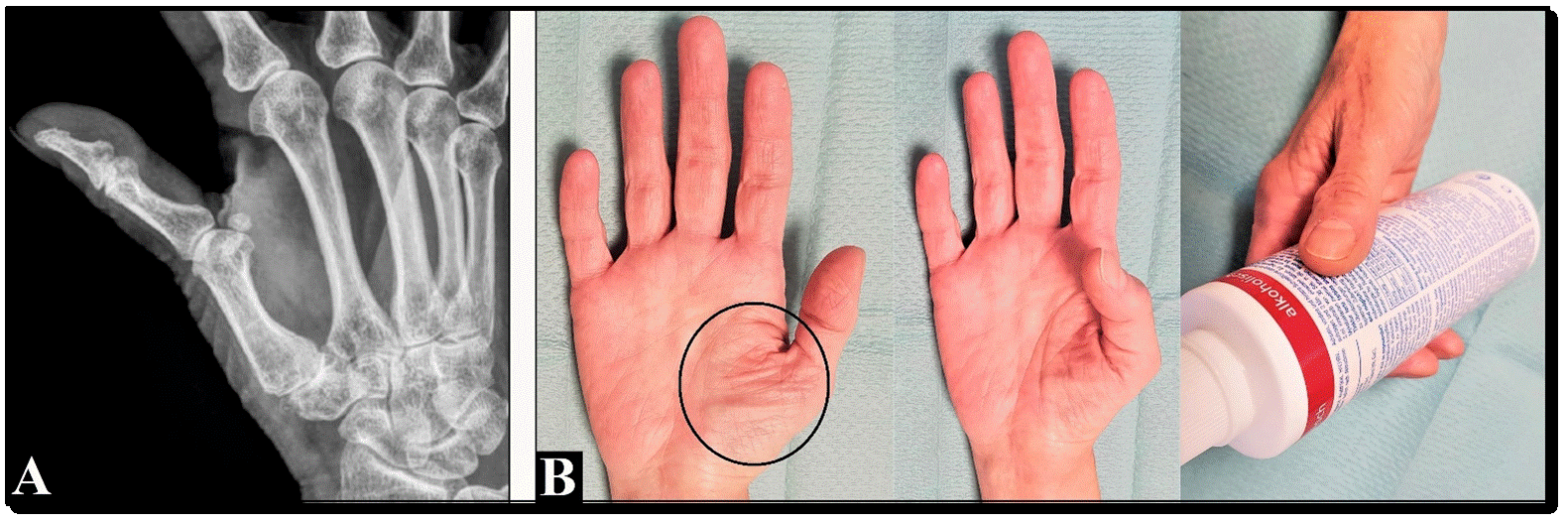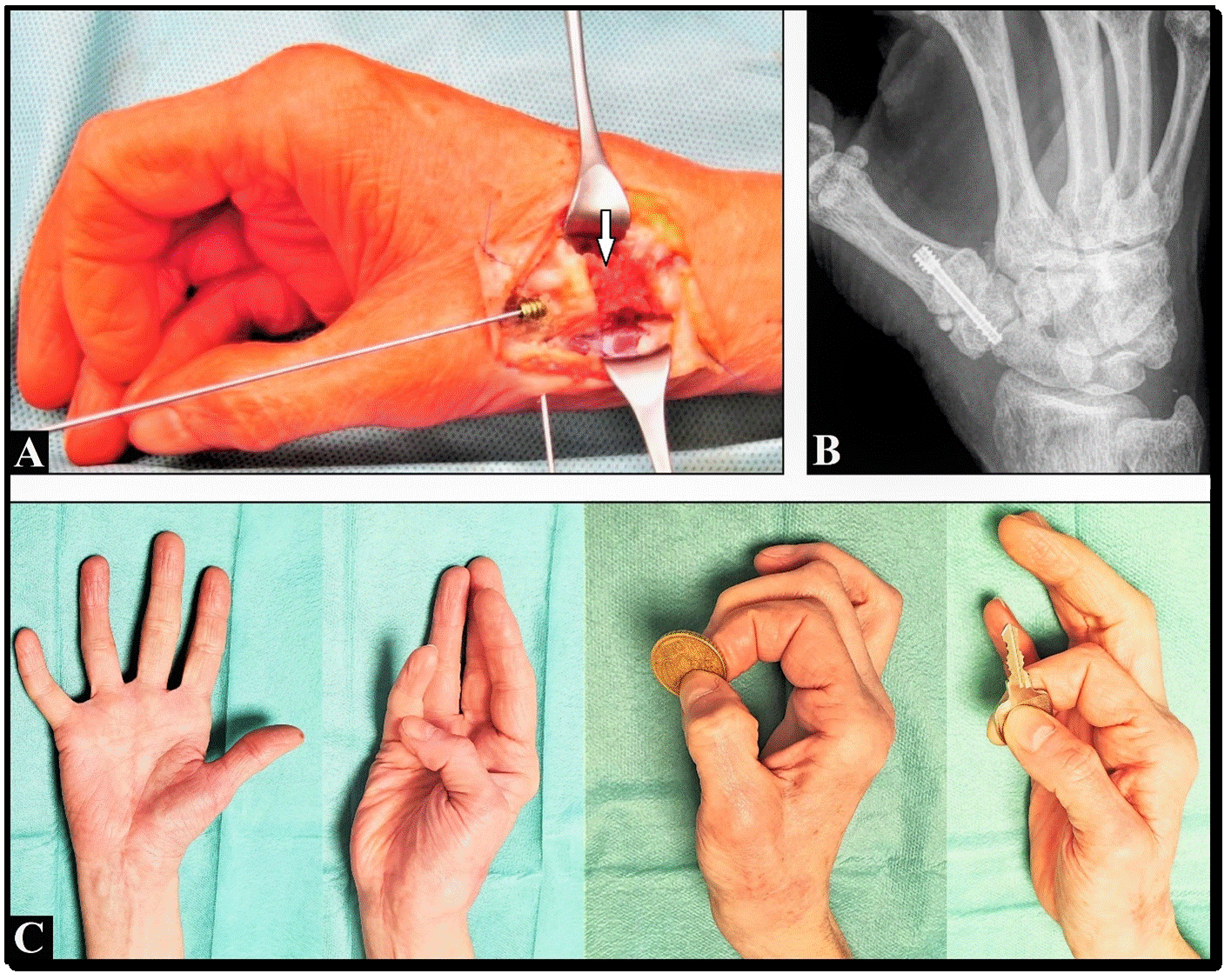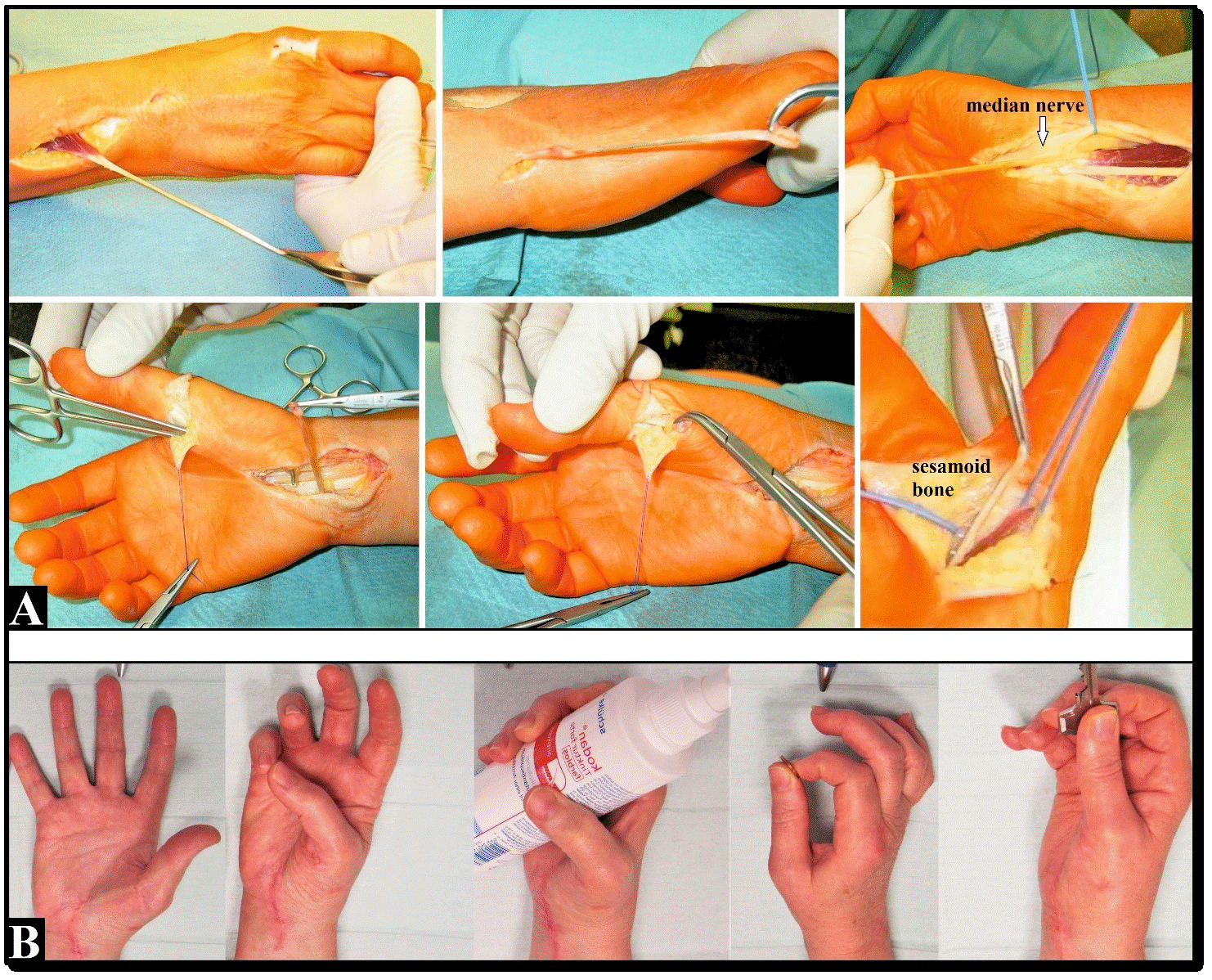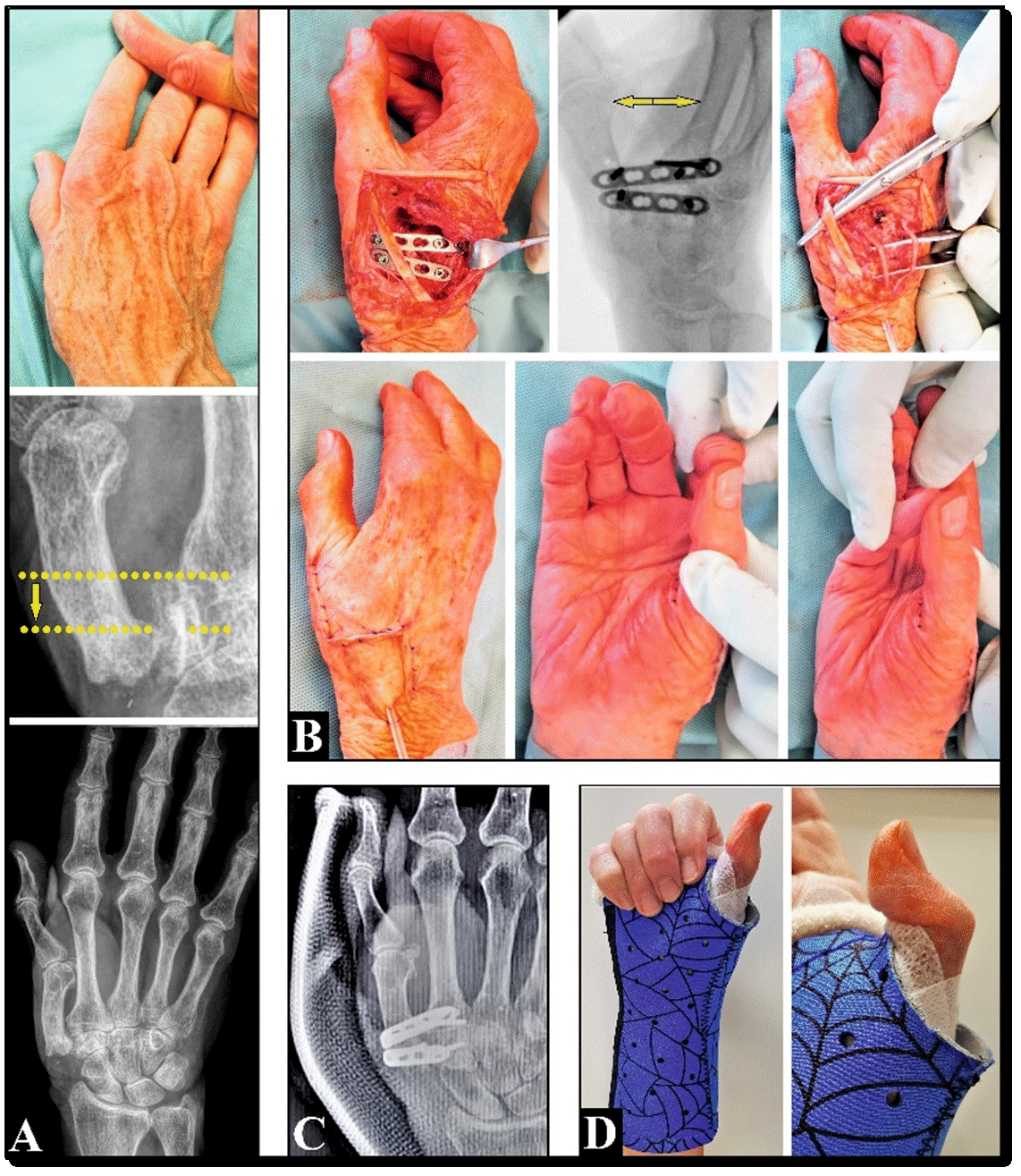Carpometacarpal osteoarthritis of the thumb can be associated with various concomitant disorders such as the carpal tunnel syndrome. We describe an uncommon case of longstanding hypoproteinemia leading to irreversible thenar muscle atrophy and mimicking an advanced stage of carpal tunnel syndrome that required a thumb carpometacarpal joint arthrodesis despite some limitations of this procedure.
thumb, carpometacarpal joint, osteoarthritis, thenar muscle atrophy, carpal tunnel syndrome, hypoproteinemia, arthrodesis
CMCJ I: Carpometacarpal Joint of the Thumb; OA: Osteoarthritis; CTS: Carpal Tunnel Syndrome; VAS: Visual Analogue Score; PRWE: Patient-Rated Wrist Evaluation.
The thumb carpometacarpal joint (CMCJ I) is the most common site of osteoarthritis (OA) in the hand with post-menopausal female predominance and it can be associated with concomitant carpal tunnel syndrome (CTS) in 25% of cases [1-3]. We present one case in which hypoproteinemia mimicking an advanced stage of CTS that required a CMCJ I arthrodesis.
A 57-year-old underweighted female (body height 1.55 m) presented with right advanced stage of symptomatic CMCJ I OA for many years (Figure 1A). She reported about loss of her body weight within the last 10 years from 60 kg (body mass index 25) to 43 kg (body mass index 17,9). The cause for the underweight was unknown by the patient, and she has ruled out a malnutrition. Additionally, she noted tingle at all fingertips of both hands. Clinical examination revealed a marked restriction of abduction/oppostion/circumduction of the thumb associated with an insufficient object grasp, and a pronounced thenar muscle atrophy (also left) (Figure 1B). Pain in visual analogue score (VAS, scale 0-10) was 9, Patient-rated wrist evaluation (PRWE, 0-100 points) 81, and grip strength (Jamar dynamometer) 28% to the opposite hand. Electroneurographic examination did not reveal peripheral nerve compression syndromes at her both hands nor a cervical spine disorder that led to the diagnosis by the neurologist of a polyneuropathy in the absence of any motor deficits with unknown etiology. The further diagnostic procedure yielded a hypoproteinemia with a pronounced decreased serum level of 55.7 g/l (normal range 65.0 – 85.0 g/l).

Figure 1 (Case presentation). (A) Preoperative radiograph showing the advanced stage of right CMCJ I OA. (B) Preoperative clinical photographs showing the pronounced thenar muscle atrophy (circles) resulting in an insufficient abduction/opposition/circumduction of the thumb with an incomplete object grasp
The arthrodesis of the CMCJ I was done utilizing an iliac crest corticocancellous bone graft to obtain the length of the thumb and a 3,0 mm cannulated titanium headless compression screw (DePuySynthes, USA) with the thumb in 50° abduction and 30° angled radially to the longitudinal axis of the second metacarpal bone after release of the adduction contracture with widening of the first web and resection of the corresponding articular surfaces (Figure 2A). Postoperatively, the right wrist with the thumb was immibilized in plaster splint for four weeks. At the 1-year follow-up we observed an uneventful bony healing and all functional tasks without a rotation failure of the thumb could be performed again. (Figure 2B-C). Pain and PRWE had improved to 9 and 32, and grip strength to 74% to the opposite hand. The patient was very satisfied with the outcome allowing performance of most activities in daily living again.

Figure 2 (Case presentation). (A) Intraoperative clinical photograph showing the CMCJ I arthrodesis utilizing a 3,0 mm cannulated titanium headless compression screw and an iliac crest corticocancellous bone graft (arrow). (B) At the 1-year follow-up there was an uneventful bony healing radiographically. (C) Clinical photographs at the 1-year follow-up demonstrating the significant improvement of the thumb function. Note there is no rotation failure of the thumb
Grip strength is one of the most relevant functional aspect to maintain independence and quality of life in humans. When decreased, it can have an impact on their functional capacity, but noted that it can decrease physiologically to 43% and more in healthy subjects starting with age of 60 years [4]. Muscle atrophy as one cause for decreased grip strength is a physiological age-related process as well, but it may arise (excluding central or peripheral nerve disorders) either by work-related overuse, longstanding immobilization, malnutrition, chronic diseases of various internal organs, or by immune disorders [5]. With our patient, the symptoms of tingle at all fingertips and impaired opposition/circumduction of the thumb were similar to an advanced sensomotor CTS (i.e. distal median nerve palsy) [6]. However, the etiology of the hypoproteinemia that led to the pronounced thenar muscle atrophie associated with a highly restricted movement of the thumb (in combination with the longstanding painful CMCJ I OA) was unclear. Because of the longstanding anamnesis the muscle atrophy had to be considered as irreversible.
Treatment options for advanced stage of CMCJ I OA are the motion-preserving trapeziectomy (i.e. resection arthroplasty with or without ligamentous reconstruction, tendon interposition or suspension) and total CMCJ replacement that can be combined with other surgical wrist procedures, and the motion-restricting CMCJ I arthrodesis [7-10]. For treatment of irreversible peripheral motor nerve palsies a motion-enhancing procedure by a tendon transfer procedure is the method of choice, but detected only when a normal muscle activity of the donor muscle-tendon unit for the affected joint is present that was not given with our patient [11]. For thenar muscle atrophy caused by an irreversible CTS the Burkhalter opponensplasty (transfer of the extensor indicis proprius, motor innervated by the non-affected antagonistc radial nerve) is one option in order to improve opposition/circumduction of the thumb (Figure 3A-B) [12,13]. Theoretically, the opponensplasty provides the option to combine it with a thumb motion- and length-preserving total CMCJ I replacement [2,14], but it was too risky for us because it had to be suspected with our patient that the muscle atrophy seemed to be generalized (involving possible donor muscle-tendon units). The combination of the opponensplasty with the motion-preserving trapeziectomy had to be considered critical as well because for the success of a tendon transfer procedure the physiological forces of the donor muscle-tendon unit should be preserved [11]. The problem of trapeziectomy is that this procedure does not obtain normal length of the thumb potentially leading to a painful impingement between the base of the first metacarpal and scaphoid or trapezoid bone (Figure 4A) associated with non-physiological muscle and tendon forces often resulting in a decreased stability in the adjacent metacarpaophalangeal joint, impaired grip strength and key pinch forces as compared to a total CMCJ I replacement [15-20]. Therefore, the CMCJ I arthrodesis was the only option of choice in order to improve the functionality of the entire affected hand with our patient.

Figure 3 (56-year-old female presented with right irreversible CTS, the Burkhalter oppensplasty was performed). (A) Intraoperative clinical photographs showing dissection of the extensor indicis proprius with it ulnar sided subcutaneous transposition to volar and to the metacarpophalangeal joint of the thumb, the tendon was sutured at the sesamoid bone. (B) Six months after surgery circumduction of the thumb had been sufficiently restored providing all functional tasks
CMCJ I arthrodesis with or without bone grafting provides a stable and powerful thumb. It is recommended for younger patients with high claims in occupational work and leisure, but it should not be done in the presence of concomitant OA at the metacarpophalangeal joint potentially leading to an arthrodesis as well [2,7,21-24]. Noted that 80% of patients received a metacarpophalangeal joint arthrodesis in the presence of a well functioning CMCJ I reported difficulties such as slicing bread, using scissors, opening jars, handling small or heavy objects, writing, using a keyboard, or writing messages on a mobile phone [25]. Another indication is an irreducible Z - deformity of the thumb with closure of the first web and hyperextension in the metacarpophalangeal joint [26]. The outcome is reported to be controversial, patients satisfaction can be high but only 64% of patients would undergo the procedure again themselves depending on the postoperative pain relief [27]. No significant age-related differences in the patients satisfaction were found (55 years and younger vs. 65 years and older), however, due to its high complication rate it is not always recommended for women aged 40 years and older, and the patient's satisfaction is only high in 88% of cases when osseous fusion is obtained [28-31]. Non-union is observed in up to 20% of cases especially if K-wires were used which underlines the need for a stable fixation such as recommended with the use of a cannulated compression screw [32,33]. Moreover, patients often compensate the loss of function after CMCJ I arthrodesis by developing increased non-physiological range of motion in the scaphotrapeziotrapezoidal and metacarpophalangeal joint potentially leading to overuse-related disorders [34]. The majority of compensation is observed in the metacarpophalangeal joint with a relative portion of 75% and followed by 25% in the scaphotrapeziotrapezoidal joint [35]. The incidence of scaphotrapeziotrapezoidal OA after CMCJ I arthrodesis is reported to be 16.2% radiographically; but noted that only 3.3% of them are symptomatically and for those cases the conversion to trapeziectomy is recommended [36]. For a failed CMCJ I arthrodesis in the absence of scaphotrapeziotrapezoidal OA the conversion to a motion-restoring total CMCJ I replacement that may decrease overuse-related disorders in the adjacent joints can improve the patients satisfaction in single cases as well [37]. Noted that for a failed trapeziectomy the thumb-index metacarpal arthrodesis with or without involvement of the trapezoid bone (Figure 4A-D) or an insertion of a joint prosthesis with the cup placed into the scaphoid bone (i.e. scaphometacarpal arthroplasty) is also to be considered as a salvage option of choice [38-40]. The limitation of a scaphometacarpal arthrodesis is that this procedure impairs the wrist biomechanics (i.e. restriction of mobility in the midcarpal joint), thus, it is recommended only if various previously performed procedures at the CMCJ I have been failed [41,42]. For specific cases which require excision of the entire trapez and first metacarpal bone the arthrodesis between the proximal phalanx of the thumb and the second metacarpal bone is described [43].

Figure 4 (81-year-old female presented with poor outcome one year after right trapeziectomy in another insitution due to a suggested failed total CMCJ I replacement performed in the same institution, the thumb-index metacarpal arthrodesis with involvement of the trapezoid bone was performed by us). (A) Radio- and clinical photographs two years after trapeziectomy showing the marked shortening of the thumb (pointed lines and arrow) resulting in painful impingement with radiographic signs of spontaneous bony bridging between the first metacarpal and trapezoid bone, adduction contracture with closure of the first web, and Z-deformity of the thumb. (B) The arthrodesis was done with two 2,0 mm locking titanium plates (DePuySynthes, USA) and two iliac crest corticocancellous bone grafts after release of the adduction contracture and widening of the first web (double arrow) resulting in restoration of sufficient tip pinches with the index to the little finger. Note that there is no rotation failure of the thumb. All dorsal sensory branches of the radial nerve were carefully dissected and obtained. (C) Postoperative radiograph showing correct placement of the plates. (D) Postoperative care with immobilization in a thermoplastic splint for six weeks providing active movement in the interphalangeal joint of the thumb. Unfortunately, the plates had to be removed in another institution again due to clinical manifestation of a deep infection four weeks after surgery primarily treated with antibiotic drugs by the family doctor without the opportunity of clinical examination by us. The further course is unknown to us
The author declares no potential conflicts of interest with respect to the research, authorship, and/or publication of this article.
None.
The author would like to thank Dr. Tino Beylich (Klinikum Bad Salzungen GmbH, Germany), Dr. Ivo Nennstiel (SRH Klinikum Suhl, Germany), and Dr. Heiner Schmitz (Medical Centre Dr. Zollmann & Colleagues Jena, Germany) for their excellent support in treating our patients.
- Van der Oest MJW, Duraku LS, Andrinopoulou ER, Wouters RM, Bierma-Zeinstra SMA, Selles RW, Zuidam JM (2021) The prevalence of radiographic thumb base osteoarthritis: a meta-analysis. Osteoarthritis Cartilage Jun;29(6):785-792.
- Schmidt I (2021) Trapezial dysplasia and concomitant disorders around the thumb can influence the outcome after total carpometacarpal joint replacement: Report of two cases, short review of literature, and update to the ArpeTM prosthesis. Trauma Emerg Care 6.
- Martin-Ferrero M, Simón-Pérez C, Coco-Martín MB, et al. (2020) Trapeziometacarpal total joint arthroplasty for osteoarthritis: 199 patients with a minimum of 10 years follow-up. J Hand Surg Eur Vol 45: 443-451.
- Lenardt MH, Hammerschmidt Kolb Carneiro N, Betiolli SE, et al. (2016) Factors associated with decreased hand grip strength in the elderly. Esc Anna Nery 20: e20160082.
- Fanzani A, Conraads VM, Penna F, Martinet W (2012) Molecular and cellular mechanisms of skeletal muscle atrophy: an update. J Cachexia Sacropenia Muscle 3: 163-179.
- Marquardt TL, Nataraj R, Evans PJ, Seitz WH Jr, Li ZM (2014) Carpal tunnel syndrome impairs thumb opposition and circumduction motion. Clin Orthop Relat Res 472: 2526-2533.
- Schmidt I (2015) Surgical Treatment Options in Thumb Carpometacarpal Osteoarthritis: A Recent Literature Overview Searching for Practice Pattern with Special Focus on Total Joint Replacement. Curr Rheumatol Rev 11: 39-46.
- Schmidt I (2017) Combined replacements of the wrist, ulnar head, and thumb carpometacarpal joint. Case report, technical note, and recent evidence to the ArpeTM prosthesis. Trauma Emerg Care 2.
- Kandemir G, Smith S, Schmidt I, Joyce TJ (2020) Explant analysis of a Maestro™ wrist prosthesis and calculation of its lubrication regime. J Mech Behav Biomed Mat 110: 103933.
- Langer MF, Grünert JG, Unglaub F, Richter M, van Schoonhoven J, Oeckenpöhler S (2021) [Resection arthoplasty of the trapezium with ligament reconstruction and tendon interposition and variations]. Oper Orthop Traumatol Jun 9.
- Schmidt I (2017) Irreparable Radial Nerve Palsy Due to Delayed Diagnostic Management of a Giant Lipoma at the Proximal Forearm Resulting in a Triple Tendon Transfer Procedure: Case report and Brief Review of Literature. Open Orthop J 11: 794-803.
- Burkhalter W, Christensen RC, Brown P (1973) Extensor indicis proprius opponensplasty. J Bone Joint Surg Am 55: 725-732.
- Lemonas P, Laing T, Ghorbanian S, Malahias M, Ragoowansi R (2012) Extensor indicis proprius opponensplasty – the Burkhalter revisited. J Hand Microsurg 4: 47-49.
- Bigorre N, Petit A, Gibaud-Dumartinet R, Saint-Cast Y, Raimbeau G (2021) Revision of Arpe® trapeziometacarpal prosthesis by isolated head and linear exchange in five patients. Hand Surg Rehabil 40: 305-308.
- Degeorge B, Dagneaux L, Andrin J, Lazerges C, Coulet B, Chammas M (2018) Do trapeziometacarpal prosthesis provide better metacarpophalangeal stability than trapeziectomy and ligamentoplasty? Orthop Traumatol Surg Res 104: 1095-1100.
- Shah DS, Middleton C, Gurdezi S, Horwitz MD, Kedgley AE (2020) The Effect of Surgical Treatments for Trapeziometacarpal Osteoarthritis on Wrist Biomechanics: A Cadaver Study. J Hand Surg Am 45: 389-398.
- Hansen TB (2021) Joint replacement for trapeziometacarpal osteoarthritis: implants and outcomes. J Hand Surg Eur Vol 46: 115-119.
- Athlani L, Motte D, Martel M, Moissenet F, Mottet J, Jean-Yves Beaulieu JY (2021) Comparison of simulated key pinch after three surgical procedures for trapeziometacarpal osteoarthritis: a cadaver study. J Hand Surg Eur Vol May 18.
- Renfree KJ, Roarke MC (2021) Thumb Metacarpal-Trapezoid Impingement as an Etiology of Pain After Trapeziectomy and Basal Joint Soft Tissue Arthroplasty: A Case Series. J Hand Surg Am Apr 9;S0363-5023(21)00126-X.
- Rouveyrol M, de Villeneuve Bargemon JB, Levet P, Mattéi JC, Legré R, Jaloux C (2021) Revision of trapeziectomy failures in thumb base osteoarthritis: retrospective analysis of ten cases and review of the literature. Hand Surg Rehabil Published online April 6.
- Parvex PO, Egloff DV (2001) Surgery for root arthrosis: retrospective study and search for an algorithm. Chir Main 20: 351-361.
- Lutonský M, Pellar D (2006) Arthrodesis of the carpometacarpal joint of the thumb. Acta Chir Orthop Traumatol Cech 73: 345-3499.
- Ladd AL, Goodman AD, Weiss APC (2021) Design Considerations for Carpometacarpophalangeal Joint Arthroplasty. In: Arthroplasty of the Upper Extremity (eds. King GJW and Rizzo M) 199-213 (Springer Nature Switzerland AG).
- Borgers A, Vanhees M, Verstreken F (2021) Primary Carpometacarpophalangeal Joint Arthroplasty. In: Arthroplasty of the Upper Extremity (eds. King GJW and Rizzo M) 2015-234 (Springer Nature Switzerland AG).
- Rigó IZ, Røkkum M (2013) Not all non-rheumatoid patients are satisfied with thumb metacarpophalangeal joint arthrodesis. J Plast Surg Hand Surg 47: 144-146.
- Teissier J, Gaudin T, Marc T (2001) Problems with the metacarpophalangeal joint in the surgical treatment of osteoarthritis by inserting an ARPE type joint prosthesis. Chir Main 20: 68-70.
- van Laarhoven CMCA, Schrier VJMM, van Heijl M, Schuurman AH (2019) Arthrodesis of the Carpometacarpal Thumb Joint for Osteoarthritis; Long-Term Results Using Patient-Reported Outcome Measurements. J Wrist Surg 8: 489-496.
- Hattori Y, Doi K, Dormitorio B, Sakamoto S (2016) Arthrodesis for Primary Osteoarthritis of the Trapeziometacarpal Joint in Elderly Patients. J Hand Surg Am 41: 753-759.
- Vermeulen GM, Brink SM, Slijper H, Feitz R, Moojen TM, Hovius SE, et al. (2014) Trapeziometacarpal arthrodesis or trapeziectomy with ligament reconstruction in primary trapeziometacarpal osteoarthritis: a randomized controlled trial. J Bone Joint Surg Am 96: 726-733.
- De Smet L, Van Meir N, Verhoeven N, Degreef I (2010) Is there still a place for arthrodesis in the surgical treatment of basal joint osteoarthritis of the thumb? Acta Orthop Belg 76: 719-724.
- De Smet L, Vaes F, Van Den Broecke J (2005) Arthrodesis of the trapeziometacarpal joint for basal joint osteoarthritis of the thumb: the importance of obtaining osseous union. Chir Main 24: 222-224.
- Singh HP, Hoare C, Beresford-Cleary N, Anakwe R, Hayton M (2015) Nonunion after trapeziometacarpal arthrodesis: comparision between K-wire and internal fixation. J Hand Surg Eur Vol 40: 351-355.
- Zdráhal M (2009) Arthrodesis of the carpometacarpal joint of the thumb using a cannulated screw. Acta Chir Orthop Traumatol Cech 76: 326-328.
- Neumann DA, Bielefeld T (2003) The carpometacarpal joint of the thumb: stability, deformity, and therapeutic intervention. J Orthop Sports Phys Ther 33: 386-399.
- Klimo GF, Verma RB, Baratz ME (2001) The treatment of trapeziometacarpal arthritis with arthrodesis. Hand Clin 17: 261-270.
- Rizzo M, Moran SL, Shin AY (2009) Long-term outcomes of trapeziometacarpal arthrodesis in the management of trapeziometacarpal arthritis. J Hand Surg Am 34: 20-26.
- De la Red-Gallego MA, Barrera-Ochoa S, Sanchez Crespo MR (2021) Total thumb carpometacarpal arthroplasty for failed trapeziometacarpal joint arthrodesis. Hand Surg Rehabil 40: 347-349.
- Hess DE, Drace P, Franco MJ, Chhabra AB (2018) Failed Thumb Carpometacarpal Arthroplasty: Common Etiologies and Surgical Options for Revision. J Hand Surg Am 43: 844-852.
- Yan M, Zelenski M, Bustos SS, Kuruoglu D, Moran SL (2021) Revision/Failed Carpometacarpophalangeal Joint Arthroplasty. In: Arthroplasty of the Upper Extremity (eds. King GJW and Rizzo M) 235-251 (Springer Nature Switzerland AG).
- Chiche L, Lamarre H, Barbary S, Teissier J (2020) Scaphometacarpal arthroplasty: a report of ten cases of trapeziometacarpal prosthesis and trapeziectomy revision. J Hand Surg Eur Vol 45: 483-487.
- Goorens CK, Van Schaik DE, Goubau JF (2015) Surgical treatment after a failed trapeziectomy: A case report. Chir Main 34: 205-209.
- Van Royen K, Vanmierlo B, Goorens CK, Goubau J (2020) Scaphometacarpal arthrodesis with autologous structural bone graft as a salvage procedure after failed trapeziectomy - Surgical technique and initial results. Hand Surg Rehabil 39: 539-544.
- Hein C, Watkins B, Zuckerman LM (2016) Thumb Reconstruction with Arthrodesis to the Second Metacarpal following Sarcoma Excision. Case Rep Orthop 2016:8061036.




